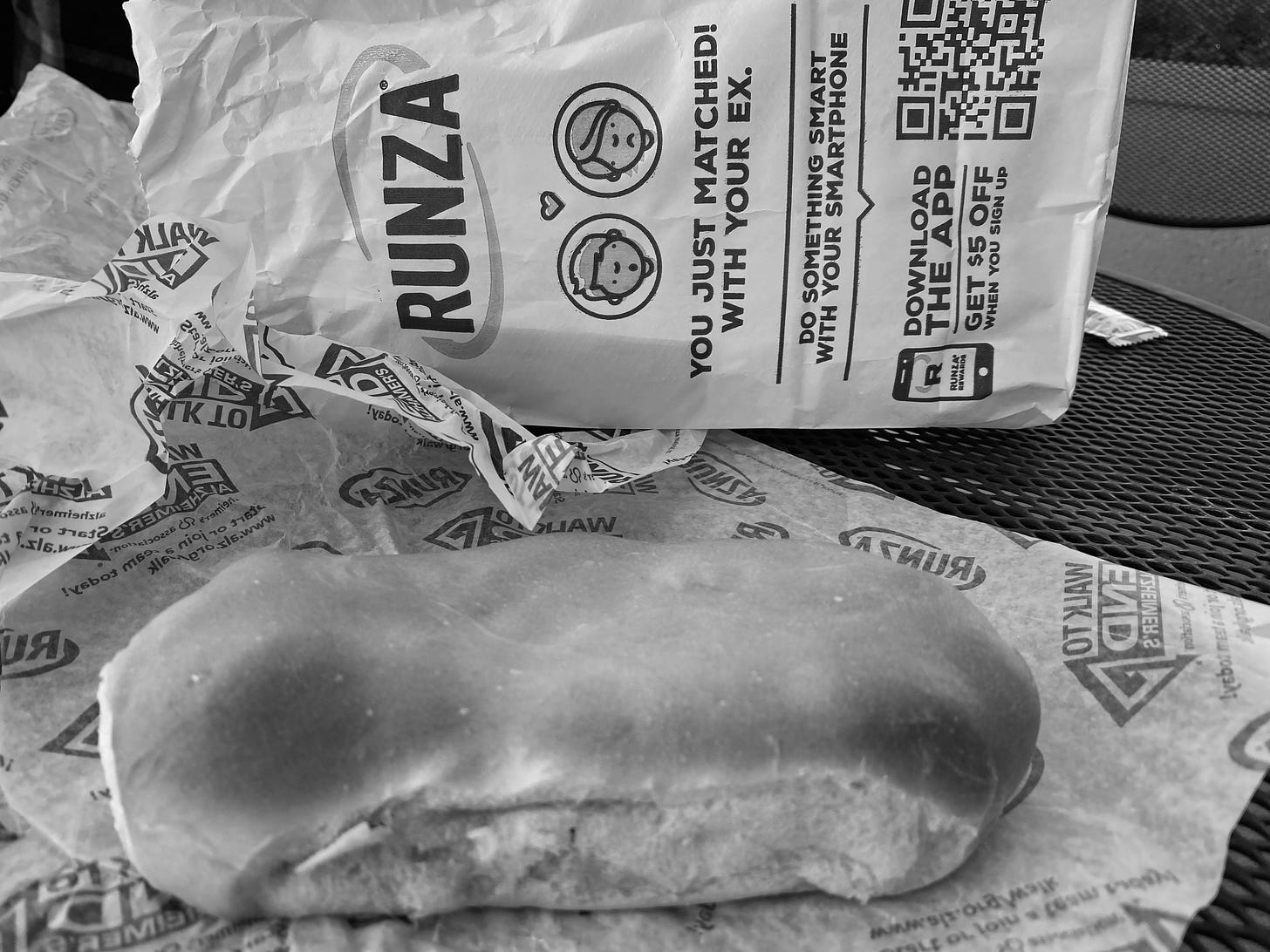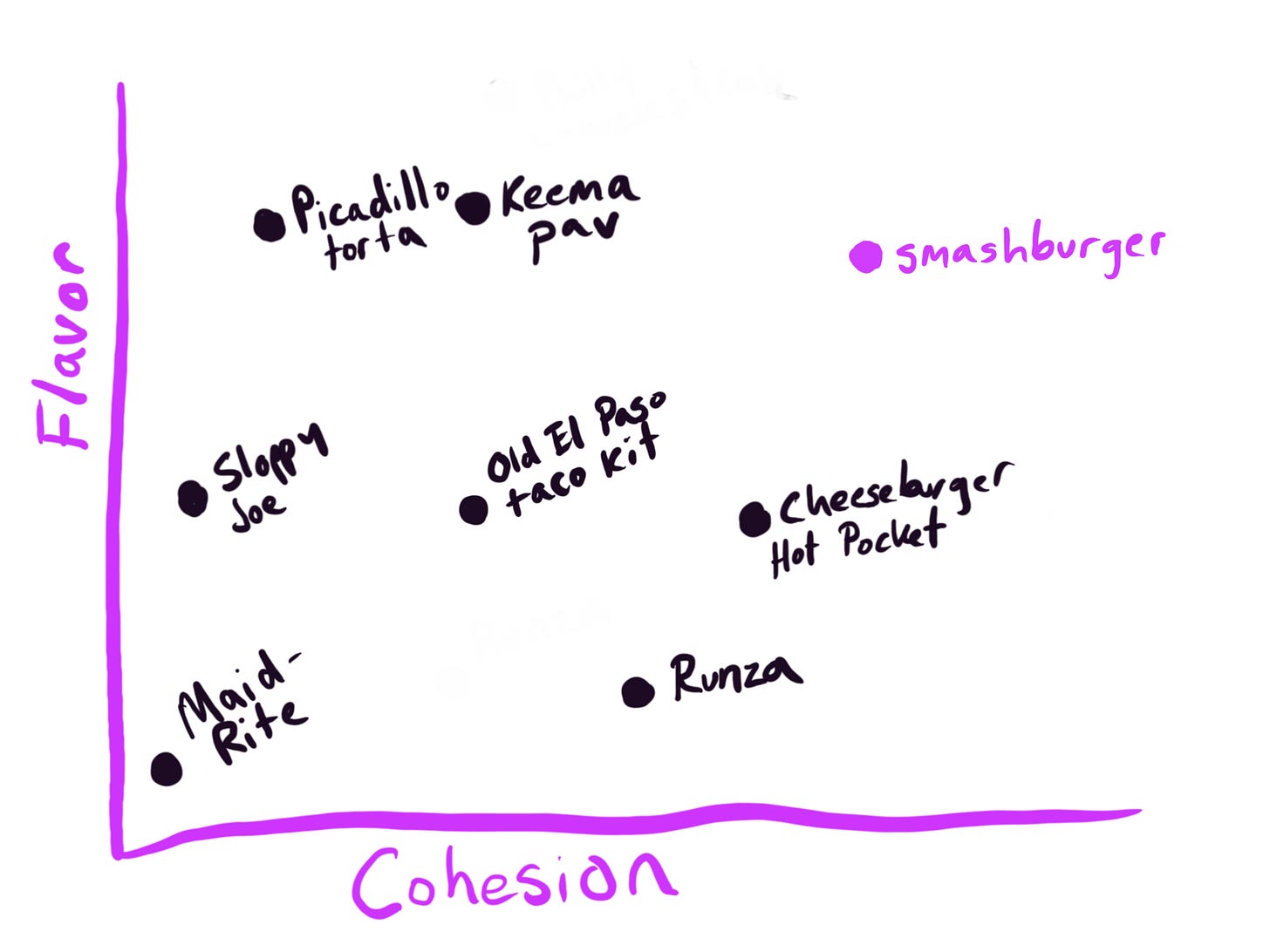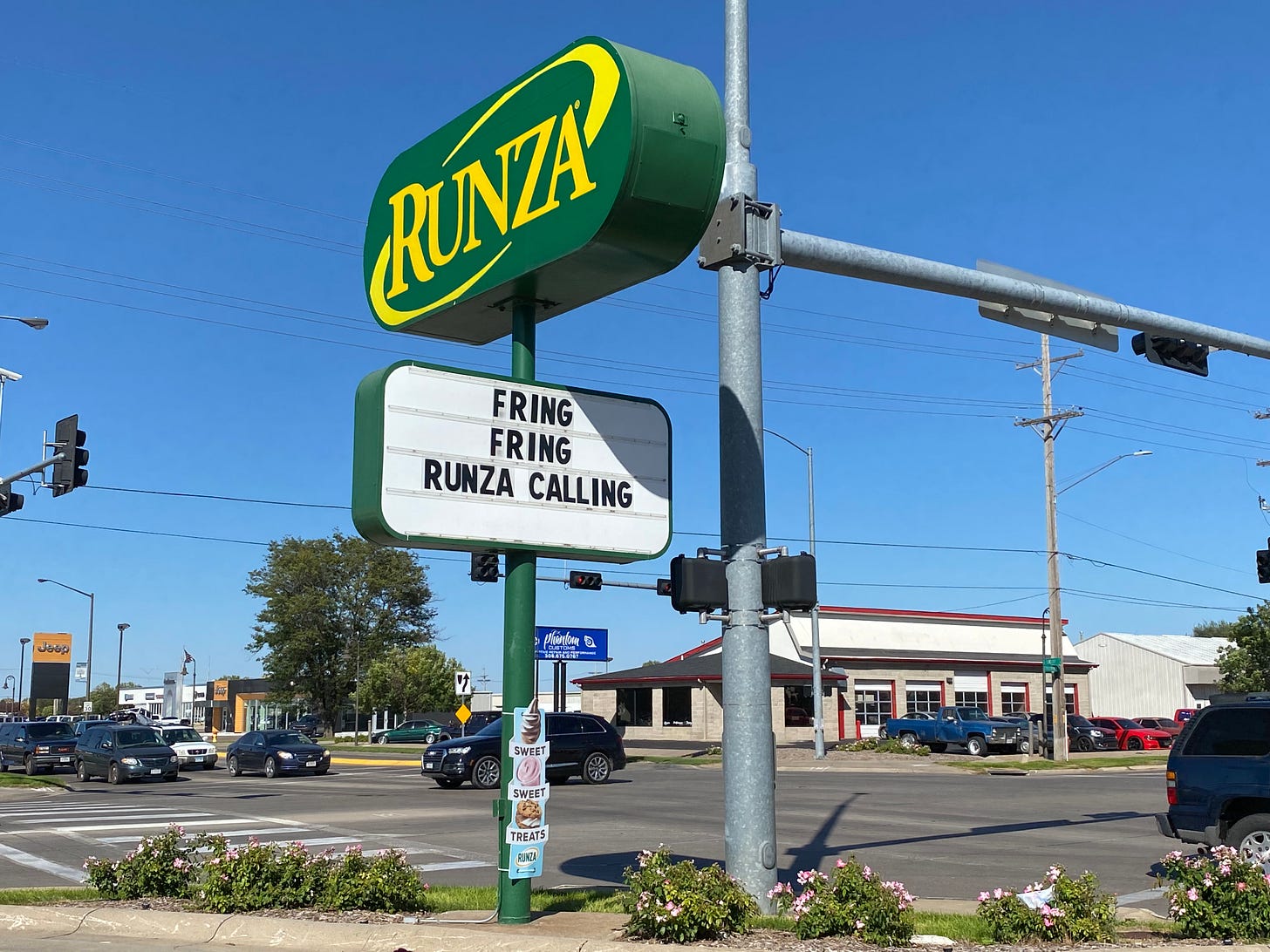Some Midwestern food trends I’ll defend to the pain—spring salad, hot beef sundaes, food mags geared toward busy home cooks instead of twentysomething social climbers with memberships at Pure Barre.
But this newsletter is a place for radical candor and canned rancor. It is a safe space for Inconvenient Truths. And one of those truths is that loose meat sandwiches are terrible.
I was reminded of this last week at the Runza in Grand Island, Nebraska. I was on the back half of a very long drive home from Montana, where I’d spent a few days hiking and camping, and I could not resist the siren song of a restaurant painted to resemble a John Deere showroom.
The Runza is a Nebraska delicacy that, like much of the Midwest, is vaguely Eastern European in a ship of Theseus kind of way. If you’ve never had a Runza, it’s not hard to imagine. It’s essentially a bierock masquerading as a Hot Pocket—a soft, dough-y bread lozenge scantily filled with steamed ground beef and cabbage. It is a sandwich that answers two unnecessary questions:
What if meat were Grape Nuts?
What if a hamburger bun was a one-piece?
You can get them in many appealing flavors, such as “original” and “cheese.” It is a sandwich that tastes exactly like the sum of its parts and that should only be photographed in black and white, for art reasons. The best part of the Runza is the cabbage—at least you know you’ll be tasting it later.

Notable: after a week of subsisting almost entirely on couscous and Robert Irvine’s FITCRUNCH protein bars, that Runza was still the worst thing I ate.1
I should acknowledge here a certain amount of anti-Nebraska bias, owing both to its position as the interminably long “Gateway to the West” and my rural Iowa upbringing. (The Cornhuskers are stolen valor. Iowa is undefeated in corn production/huskery.)
But the Runza is by no means the worst offender in the Loose Meat genus, and Iowa’s native versions are even worse. Both the “Maid-Rite” and the “tavern” sandwich are distinctly Iowan, like taco chips on pizza or hog cholera, and the differences between the two are marginal. Both sandwiches feature an ordinary white hamburger bun piled with steamed, gray meat nubbins doled out with an ice-cream scoop. The #nubbins evacuate the sandwich the moment you pick it up; they don’t like it any more than you do.
Both sandwiches also call for you to strain the fat from the meat once it’s steamed, lest you perish from zestiness. I suspect this is part of the reason they’ve remained popular with older Midwesterners—nothing about these sandwiches is digestively taxing. The Maid-Rite was the only restaurant in my college town that stopped serving dinner at 5 PM (“last call” for octogenarians).2
Time for some Midwestern Loose Meat History:
The Solutum Carnem Epoch
1924. Dave Heglin starts selling “tavern sandwiches” at his Sioux City, Iowa restaurant Ye Olde Tavern.3
1926. Butcher Fred Angell opens the first Maid-Rite in Muscatine, Iowa, serving sandwiches almost identical to Heglin’s “taverns.” Angell’s innovation is steaming the ground beef in a mysterious “dark liquid” that is ostensibly a company secret but is definitely root beer.
1927. Dusty Rhoades starts selling a similar loose-meat sandwich at Canteen Lunch in the Alley in Ottumwa, Iowa. Ottumwans call the sandwiches “canteens,” but the name doesn’t really take off outside of Southeastern Iowa.
1949. Sally Everett opens the first Runza Drive-Inn in Lincoln, Nebraska with her brother, Alex Brening.
1990. Sally’s son and grandson—the Donalds Everett Sr. and Jr.—make a bid for the Soviet dollar, shipping hundreds of frozen Runzas to the Soviet Ministry of Agriculture in a desperate pitch to expand the franchise to the republic of Latvia. The deal falls through when Latvia declares independence from the Soviet Union. (“We like to open restaurants, but not deal with the extraneous situations that go on there," Everett Jr. tells The Lincoln Journal Star.)
1993. Tom Arnold and Roseanne Barr capitalize on the success of Roseanne by opening Roseanne & Tom's Big Food Diner in Eldon, Iowa. The diner serves loose meat sandwiches modeled after those served at the fictional Lanford Lunch Box—which, in turn, are modeled after those served at Canteen Lunch in the Alley in Ottumwa, where Arnold was born.4
A Thousand Midwesterners Can Be Wrong
Nostalgia’s a hell of a drug, and I’m not going to get too testy with my cornfed brethren for craving a big pile of Beef Crumbs now and then. But my contention is that Midwestern loose meat sandwiches are by construction terrible. They defy the Two Core Principles of sandwich making: they’re low flavor and low cohesion.
It didn’t have to be this way.
The Midwest isn’t the global progenitor of loose meat sandwiches. Many other food cultures have crumblins’, but most of them up the ante by actually seasoning or browning the meat.
The Maid-Rite, by defiant contrast, thrives at the intersection of multiple ills. It’s seasoned like an O-Town record and structured like a Kandinsky painting. It’s difficult to eat and difficult to love, and I resent it for succeeding where I have failed.
I’ve plotted a few major loose-meat players on this exacting scatter plot for reference:
Figure 1. The Flavor/Cohesion Matrix

At the top of the flavor axis, you have a tie between our two non-Midwestern entrants:
Picadillo tortas. You’ll find picadillo all over Latin America, but the Cuban variety, in which ground beef is stewed with tomatoes, raisins, and spices, feels like the closest analogue to a Midwestern Sloppy Joe.
Keema pav. This (browned! spiced!) minced-meat mixture is often served with red onion slices and a soft white roll. Mumbai street vendors will serve the pav alongside the meat, letting you assemble your own manageable bites. For this reason, it scores higher on the cohesion scale, too.
I don’t like what this graph implies about the Hot Pocket, but that’s a referendum on the Maid-Rite, not me. And Nebraska readers, let your husky hearts be soothed: the Runza wins over any of the Iowa entrants by a Grand-Island country mile. It may taste like a burp, but hey—at least it’s easy to eat.
The Haterade Reader’s Survey: Update
Thanks to the roughly 23 percent of you who took the reader’s survey last week! The responses were super helpful / the comments were predictably alarming. Proud of you. I’ll share some of the results next month in the first-ever HATERADE ANNUAL REPORT TO SUBSCRIBERS because I believe in radical financial transparency and not committing petty tax fraud. I also just find it helpful when other writers talk about this stuff.
I’ve closed the form for responses for now, but if you’ve got more feedback, drop it in the comments or email lizcook.kc@gmail.com
As always, if you want to support the Haterade Center for Loose Meat Research, subscribe, share, or throw some coins in the tip jar: @lizcookkc on Venmo | $lizcookkc on CashApp.
Yes, “Robert Irvine’s FITCRUNCH” is the full name, like “Ruth’s Chris Steakhouse” or “Jimmy Buffett’s Margaritaville.” This is not an ad, but I feel duty bound to refer to the product by its full, Christian name because 1) it is hilarious; and 2) Robert Irvine’s FITCRUNCH bars are, regrettably, the best-tasting protein bars you can buy at Costco. Every other protein bar tastes like something Tilda Swinton would toss to the coach passengers in Snowpiercer.
My Fellow Missourians: there’s a Maid-Rite in Lexington, and it’s cute as hell, but I can’t in good conscience urge you to eat there.
I keep seeing him credited as “Dave Higgin” in news write-ups, which as near as I can tell stems from a poor transcription of an interview with the restaurant’s later owner, Bertha Kaled. In case this helps future Loose Sleuths: his name is definitely Heglin. Here’s his obit from the Sioux City Journal.
The diner closed two years later, a casualty of divorce. If Eldon, Iowa sounds familiar, it might be because the tiny town is also home to the house depicted in Grant Wood’s “American Gothic.”






I love Runza but also acknowledge that last time I had lunch there the average age of the customer base was 72, and that's after accounting for my being 34.
The amount of joy it brings me that you included taverns is immense. My family are some of the only people I’ve met that call them that!